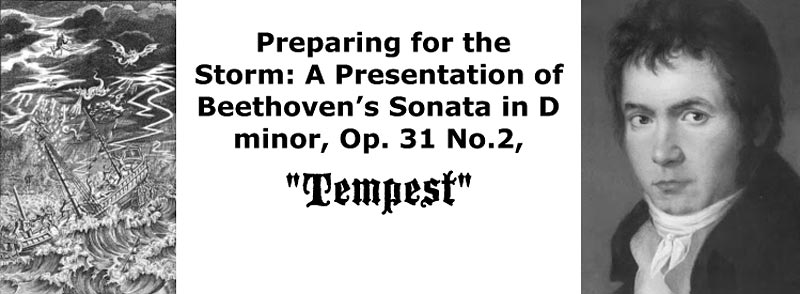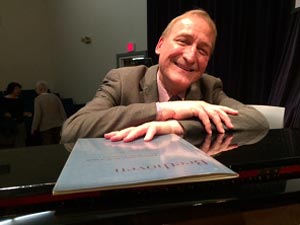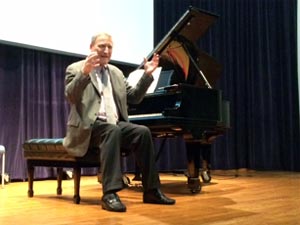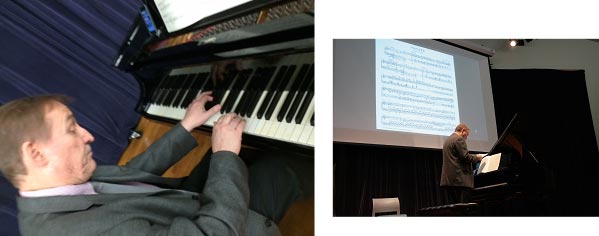Music Educators Association of New Jersey
Serving teachers and students since 1927



An insightful and engaging lecture/recital was presented by Douglas Humpherys on May 21st. Analyzing musical details notated in the score of Beethoven's Sonata, he explained how to create expression and character in performance.
Professor and Chair of the Piano Department of Eastman School of Music, Mr. Humpherys is a frequent guest artist and soloist whose concert career has spanned more than three decades across four continents. He has served on the juries of numerous major piano competitions in the United States, Asia, and Europe, founded the Eastman Young Artists International Piano Competition, and has taught hundreds of master classes at major conservatories.

Mr. Humpherys stated the importance of 'notation = character' of the composition and, therefore, of a composer. Expression and character in music is easy to hear, but hard to define. It is easier to learn about chords and harmony by experience rather than by theoretical labeling. It is difficult to interpret standard repertoire staying true to the intentions of a composer and at the same time delivering fresh and spontaneous expression. Some musicians artificially infuse their playing with too much rubato and unimportant inner voices. The best way to understand a composition is to study the notation of the composer himself.

Artistry is a combination of all the elements of musical composition: rhythm and tempo, beat and meter, dynamics, harmony, tonality, melody, instrumentation and voicing, texture (polyphonic, homophonic), pitch, timbre (tone color), and notation. Mr. Humpherys explained how all of these elements are reflected in the 'Tempest' Sonata. Interestingly, the title was not used during Beethoven's lifetime. Later, Beethoven's associate and biographer Anton Schindler claimed that this sonata was inspired by the Shakespeare play, for when he'd asked Beethoven questions about the sonata, Beethoven suggested reading 'The Tempest.' Beethoven's pupil Carl Czerny also associated this sonata with a stormy night.

The 1st movement, Largo - Allegro, sets up expectations and doesn't fulfill them. It is intensely dramatic, suspenseful, and harmonically unstable. The movement is unusual for that period, even among Beethoven's sonatas, despite its traditional sonata form. Some unusual features: there is no melody that can be actually sung; on the 1st page there are 5 tempo markings in the duration of 8 measures; the introduction is not recapitulated; there are unusual chord progressions and transitions, rapid changes in tempo, tone and texture. A haunting unaccompanied recitative section should be pedaled through long phrases. There is a proportional relationship between tempos, rhythm and accents, which should be followed exactly as written, as well as the dynamics. In all of the 32 Beethoven Sonatas, there are only two 'mp' (mezzo piano) markings, but countless 'sf' (sforzando), crescendo and diminuendo indications!
The 2nd movement, Adagio, is also in sonata form, but doesn't have a development section. Written in B flat Major, it is serene and lyrical. But there is a distant thunder heard in the left hand drum-like broken octaves. The Adagio transforms elements from the 1st movement by mirroring the opening with rolling chords and upward melodic line. It also recalls the recitative of the 1st movement. The gap between registers adds to the mysterious quality. The ornaments are expressive melodically and rhythmically.
The 3rd movement, Allegretto, is written in D minor in a sonata-rondo form. The music is flowing in a perpetuum mobile fashion, full of changing harmonies expressing storm and inner turmoil, like the 1st movement. It is based on arpeggiated chords as a main accompaniment figure, echoing chords of the previous movements.
Mr. Humpherys vividly illustrated that there are still limitless possibilities of interpretation, based on the composer's conception.

Written by Sophia Agranovich
Program Chair and Hostess
Photography, Lisa Gonzalez